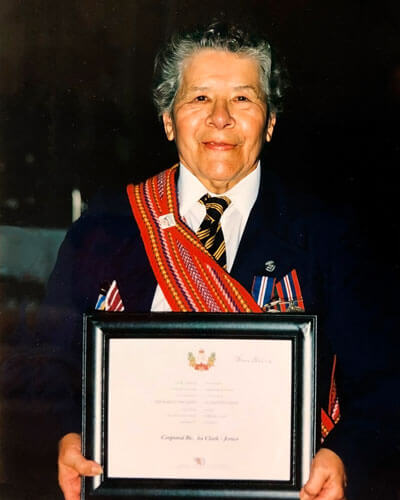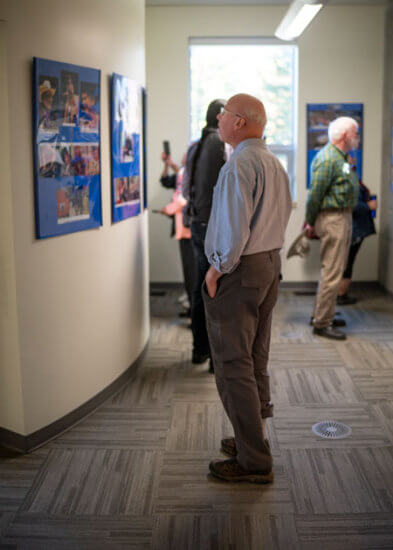Bertha Clark-Jones O.C. Art Gallery at Athabasca University celebrates a life of service
Bertha Clark-Jones was many things: a Nehiyawak (Cree) and Métis woman who advocated for the rights of Indigenous women, children, and veterans. She was a veteran of the Second World War and co-founder and first president of the Native Women's Association of Canada. She was an Order of Canada recipient-one of the many accolades bestowed on her during her life. To her family, she was also a loving mother and grandmother.
Clark-Jones was also known as "the voice" for Indigenous women in Treaty 6 Territory, remembers daughter Gail Gallupe.
"Mom was a champion and a pioneer," Gallupe says. "She spoke for Indigenous women, helping them to adjust to the ways of the world. I am very proud to have her as my mother."
On Sept. 27, Athabasca University celebrated the life and legacy of Clark-Jones by naming the Bertha Clark-Jones O.C. Art Gallery in her honour at a ceremony attended by about 100 staff, community members, and relatives. We're proud to celebrate her story and accomplishments for future generations.
Mom was a champion and a pioneer. She spoke for Indigenous women, helping them to adjust to the ways of the world. I am very proud to have her as my mother.
Gail Gallupe

A life in Athabasca
Born Nov. 6, 1922, in Clear Hills, Alta., Clark-Jones grew up in the Athabasca region with her 13 siblings and parents, Emily and Louis Houle. Clark-Jones would tell Gallupe that her father often said: "Be proud of who you are-a strong Métis woman."
At 18 years old, Clark-Jones served as a corporal and drill instructor for the Royal Canadian Air Force during the Second World War. She always considered herself a proud, patriotic Canadian.
Gallupe remembers when the family moved to Fort McMurray in the winter of 1966. It was there that Clark-Jones began her work as an advocate for women and their families who had moved from Fort Chipewyan. Although Clark-Jones moved from area to area helping Indigenous Peoples, Athabasca remained an important part of her life; in fact, she spent her later years in the community where she grew up.
Related: Nukskahtowin opens Linda Bull Memorial Garden and Bertha Clark-Jones O.C. Art Gallery
A space for connection and culture through art
The new gallery space at AU campus featured an initial installation by Métis Elder and artist Terry Lusty. The exhibit includes photographs Lusty took throughout hearings for the Truth and Reconciliation Commission of Canada.
Crystal Clark says her grandmother had memorabilia and objects that she gathered throughout her life. She always wanted to put them in a museum one day. Although her grandmother wasn't an artist, her walls were covered with traditional Indigenous pieces, such as moose hide hangings and Inuit art.
A life in Athabasca
Born Nov. 6, 1922, in Clear Hills, Alta., Clark-Jones grew up in the Athabasca region with her 13 siblings and parents, Emily and Louis Houle. Clark-Jones would tell Gallupe that her father often said: "Be proud of who you are-a strong Métis woman."
At 18 years old, Clark-Jones served as a corporal and drill instructor for the Royal Canadian Air Force during the Second World War. She always considered herself a proud, patriotic Canadian.
Gallupe remembers when the family moved to Fort McMurray in the winter of 1966. It was there that Clark-Jones began her work as an advocate for women and their families who had moved from Fort Chipewyan. Although Clark-Jones moved from area to area helping Indigenous Peoples, Athabasca remained an important part of her life; in fact, she spent her later years in the community where she grew up.
Related: Nukskahtowin opens Linda Bull Memorial Garden and Bertha Clark-Jones O.C. Art Gallery
A space for connection and culture through art
The new gallery space at AU campus featured an initial installation by Métis Elder and artist Terry Lusty. The exhibit includes photographs Lusty took throughout hearings for the Truth and Reconciliation Commission of Canada.
Crystal Clark says her grandmother had memorabilia and objects that she gathered throughout her life. She always wanted to put them in a museum one day. Although her grandmother wasn't an artist, her walls were covered with traditional Indigenous pieces, such as moose hide hangings and Inuit art.

"Although it isn't quite that, it's similar to what she'd always hoped for-a place where people can gather in connection and celebrate Indigenous art, reflecting on the contributions we've made."
Clark remembers her grandmother fondly and credits her encouragement for becoming a visual artist. The pair spent summers together when Clark attended university, which created an emotional bond of encouragement and storytelling.
Through Clark-Jones's connections with the Muriel Stanley Venne Provincial Centre and the Institute for the Advancement of Aboriginal Women, Clark worked with Stenley Venne to write a letter in support of Clark-Jones induction into the Order of Canada. Clark-Jones received the honour in 2007 in recognition of her role as a trailblazer for Indigenous rights during the 1960s and 1970s.
"She helped provide me with strength in my life in the work that I do as an Indigenous educator," Clark says. "I'll always have that connection I made with her later in her life. I'm very appreciative of that. I had always heard she did all these great things while I was growing up, but to live with her and experience her … and now reference her in the work I do? It's wonderful."
A life of service and identity as an Indigenous veteran
Clark-Jones is a well-known advocate in Treaty 6 Territory. She lived a life of service for Indigenous Peoples but, as a grandmother, there are plenty of stories people don't know, Clark says, recalling an important day they spent together in her grandmother's later years.
"She came to visit me at the end of the school year with my mom … my first teaching job on the West Coast in a remote First Nations community. Her visit overlapped with Canada Day, and she was like, 'OK, so when are the Canada Day activities happening?'"
"There's no Canada Day activities here on this reserve," Clark replied at the time, now laughing at the memory.
Despite the maltreatment of Indigenous war veterans when they returned-they didn't get land, prestige, and they weren't allowed to participate in Remembrance Day ceremonies despite giving to a nation that took everything from them-she was still a proud Canadian, Clark says.
Despite the effects of the Indian Act, specifically the Métis scrip program on her parents, and the gender discrimination that prevented Clark-Jones from residing in the Métis settlement of Paddle Prairie like her brothers, she still felt compelled to celebrate as an Indigenous war veteran.
"You know what she did? She brought a flag with her in her suitcase," Clark says. "She got us all outside and we had to roll her down this road, a walkway along the ocean. We ended up with some rez dogs, some kids, and a couple community members. We went for a nice walk, and for her, that was just something she needed to do."